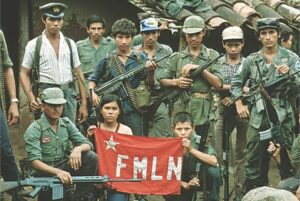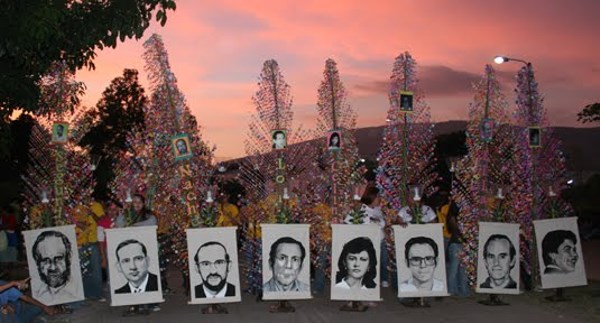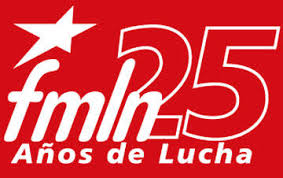I recently picked up some neat compliments about my “battle” scenes and was asked whether I’d ever seen action personally. The answer was a quick “no”, though I do spend a lot of time reading first-hand accounts of frontline experiences. And then I remembered that there had been one occasion when I came pretty close to it, and in strange circumstances.
So up to the loft to dig out my old diaries and soon I’d put together this new post.
In November and December 1989, I was part of a Merseyside volunteer brigade going to Nicaragua in Central America as an act of solidarity to help build houses following devastating flooding in Liverpool’s twin city, Corinto – on Nicaragua’s Pacific coast. Ten years earlier, revolutionary forces had overturned the regime of brutal dictator Anastasio Somoza. Ten years in which the Americans had funded counter-revolutionary “Contra” rebels to sabotage the changes delivered by the Sandinistas.
These are extracts from my diary, written at the time and in Corinto itself.
Sunday 12th November 1989
The news which has been coming in here all day is from El Salvador, where the revolutionary forces, the F.M.L.N. (Frente Farabundo Martí para la Liberación Nacional) – facing the same sort of brutal dictatorship which the Nicaraguans experienced under Somoza – has launched a series of attacks on the headquarters of the National Guard in the capital, San Salvador, and also against the Sixth Infantry Brigade at Usulután.
The border with El Salvador is only 50 kilometers north of Corinto, while the distance from Corinto to the El Salvadorean capital, San Salvador, is just a little over 400 kilometers.
Monday 13th November 1989
News today that the country is being put on a second-stage alert because of the crisis in El Salvador. There is apparently concern for our safety and discussions take place about the possibility of those of us who can handle weapons being armed. This arises from the Sandinistas’ assumption that the Americans will use this as an excuse to ‘intervene’ directly in Nicaragua by blaming them for the situation just across the gulf of Fonseca.
Those of us with any knowledge of weapons were asked to provide details. For my sins, I felt pretty stupid explaining that I’d spent a few years in the Air Cadets and won a whole batch of shooting competitions at Bisley and elsewhere. But I’d been 15 or 16 at the time – surely that didn’t count? Apparently yes, it did, and I was duly listed as “a marksman.” A dubious honour, given the circumstances.
Later, party representatives confirm that the El Salvadorean President has indeed made a statement blaming Nicaragua for “exporting its revolution” and claiming that “action would be taken.”
Tuesday 14th November 1989
US President Bush has now also blamed Nicaragua for the situation in El Salvador. The local papers carry stories and pictures of El Salvadorean army reprisals against ‘rebel’ towns and continued fighting by the FMLN – images of mounted guerrilleros wearing somberos and bandoliers of ammunition. But there are rumours, also, of the imminent arrival of aircraft carriers from the American Sixth Fleet. During the night we’re kept awake by much gunfire as the Nicaraguans practise within their coastal defences.
Wednesday 15th November 1989
News that Bush has assembled a Task Force to be sent to El Salvador, with three American warships on their way from Colombia. Today, I see a few people removing political posters from the walls of their houses, while local activists paint red crosses on the roof of the school.
Friday 17th November 1989
The important news comes from El Salvador once again – with details of the murder of six Jesuit priests at the University of Central America in San Salvador. All had been made to lie on the ground and then shot in the back of the head. The same fate had befallen their cook and her young daughter. The murders bear all the trademarks of El Salvadorean death squads, although the Jesuit centre in Honduras says there is evidence to lay the blame directly at the feet of the El Salvadorean army itself. Extraordinary. Five of the priests were Spanish nationals, and there’s already been outrage from the Spanish government and Felipe Gonzalez. The papers are all full of photographs of the corpses, with frequent reminder that the scenes are reminiscent of regular similar incidents here under Somoza.
Also, a bit reminiscent of Bishop Romero’s assassination in 1980. And there are reports of American forces on the ground in El Salvador, just across the border.
Wednesday 22nd November 1989
We talked a bit about the news from El Salvador, where bitter fighting is still taking place, with the FMLN withdrawing strategically from their strongholds to avoid the Americans hitting civilian targets…but then returning a few days later when they aren’t expected – as they’ve just done successfully in San Salvador itself.
Wednesday 29th November 1989
The threat from the El Salvador situation is still present and, as I walk to the building site this morning, teams of people are painting more huge red crosses on the roofs of important buildings, this time the medical centre next to the baseball stadium.
This threat of imminent attack is a natural one here. On the one hand “Contra” attacks tend to be concentrated in the mountain areas but are also commonplace elsewhere. On the other, with the historical precedent of at least three direct attacks on Corinto – the mining of the harbour, the shelling of the gasoline tanks, and the strafing of the main highway by fighter planes – it is natural that the close proximity of American forces in El Salvador, just across the border, is a genuinely imminent threat.
As it happens, the threat never materialised, and the building brigade completed its work, leaving Nicaragua safely – without the need to defend itself in what could so easily have been a very different outcome. It seems weird to think that, if I had ever “seen action”, it would have been there, in Central America, and possibly against the US Marine Corps. And I see that, while I recorded the events themselves, I never once described how I felt about the threat – about the danger. But now, all these years later, I remember at least some of those emotions. The outrage at the injustice inflicted upon the people of poor countries like Nicaragua by the powerful and wealthy. And the trepidation. We’d all known, before we joined the brigade, that it wasn’t a venture without some danger attached – though none of us, I think, had ever envisaged this situation. Though, in the end, nobody even mentioned the possibility of “going home”. We all just took matters day by day – and stoically, as I recall.
Although the FMLN’s November 1989 offensive may not have succeeded in overthrowing El Salvador’s corrupt government, it was certainly a turning point – because, for the first time, it became clear that the guerrilleros could not be beaten either. Soon afterwards, the US turned towards the idea of a negotiated settlement. It took a while but in 1992 a peace accord was reached. The FMLN became an officially recognised political party and from 2009 until 2014, they were elected to government.
As always, don’t the wars come easy? But doesn’t peace come hard?
And Nicaragua? Well, that’s another story.



Leave a Reply